Onam – food as rich as history

Mail This Article
Ever wondered why Onam is the festive word for food? Ummm … more than the boat races and the Onakkodis (gifts, new dresses) it’s those goodies galore on plantain leaves that make Onam what it is.
Down the years, perhaps ever since King Mahabali’s lore came into fore, people have gorged on that special sadya (feast). Food apart from the long burps let out once it goes down the gullet, there’s hardly been an iota of curiosity as to the lineage or history of the food on the leaf.
A peek into the archives to ferret out the origins of what’s served has turned up some very interesting facts about today’s Onam dishes. Join the food wagon for a trip down the ages of culinary history.
The Onasadya reminds one of Pakkanar’s grand feast. Pakkanar was second among the 12 children or the Parayi Petta Panthirukulam (12 children born from the Pariah woman to the great Brahman scholar Vararuchi). The brilliant Pakkanar once famously said that he would whip up a feast with a hundred dishes. When everybody was ready to dine he served a dollop of inji curry (a dish made with ginger and jiggery) and declared that just one serving of inji curry was equivalent to a hundred varied dishes. So much for inji power!
The curry made with ginger comes in two different styles and tastes. The first one is the inji-thairu (ginger-curd). This is a mix of curd, ground coconut and ginger.
The second avatar, inji puli or pulinji, is more like a pickle and is not Kerala’s own special recipe. It migrated from Tamil Nadu to make Kerala its permanent home. Today, injicurry holds pride of place at a Kerala sadya. Not a single feast, either merry or somber is served without injicurry.
Bheem’s aviyal
Who can resist the unmistakable aroma of curry leaves lolling about in ground coconut and warm coconut oil within a mix of the choicest vegetables? The Malayali takes pride in its aviyal and believes it’s a pure state dish. Perhaps the presence of freshly ground coconut could be behind the reasoning. But a trip to Telengana and Tamil Nadu would dispel the myth. Region-specific aviyals are served aplenty there. Nutritionist and food historian K.T.Achaya states that aviyal had its origins in Karnataka’s Udupi. In fact, the now much-sought-after dish was never even considered an item on Kerala’s traditional platter. To the pucca Malayali, like the sambar, aviyal too was an alien!
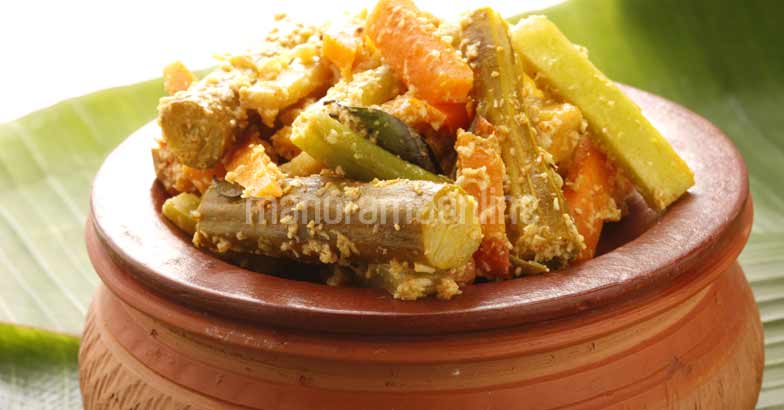
The origin of aviyal can be dated back to the Mahabharatha era when the Pandavas were on vanavas (exile). It so happened that Bheem, the greatest foodie of all, was a cook in the Virata kingdom. The story goes that not a dish was ready as lunch time inched closer. In a huff, Bheem chopped all the vegetables he could lay his hands on in a finger’s length and boiled them together. That was our first aviyal!
Pappads
What’s a sadya without pappad? The rotund crispy and its nutrient value found its first mention in the holy manuscripts of the Buddhist-Jain era in 500 BC. There are even details of how pappads are to be made. However, disputing this theory, food historians claim this wafer was born in Tibet. Yet another set of historians aver that the pappad had its origins in Bihar. It’s said that pappads were first sighted in South India’s Kodagu and Mercara regions. Pappadams down South were first “sighted” in Kannada writer Raghavenka’s book Siddharamacharithe in AD 1200.

The crispy again figured in 1485 in Kannada writer Therakanambi Bommarasa’s Sanath Kumara Charithe. Pappadam showed its earliest face in Kerala from Thalassery and Kodungallur to Chavakkad and Kuttanad. It’s from the pappad that we get clues to the earliest Buddhist settlements in Kerala.
Now for some parippu
Parippu can be called the starters. The combination is parippu and ghee. The first serving of rice is mixed with parippu curry, a spoonful of ghee and a pappad. Melting moments! Besides the taste, the combination is rich nutrition-wise. The tur dal in parippu curry was the first prime food right from the Neolithic Age, say historians. However, the parippu stepped into Kerala after the Aryan conquest of the South, claim experts. It was during the early Christian era that the dal became a popular item of food in the Asian regions of Nepal, India, Pakistan and Bangladesh.
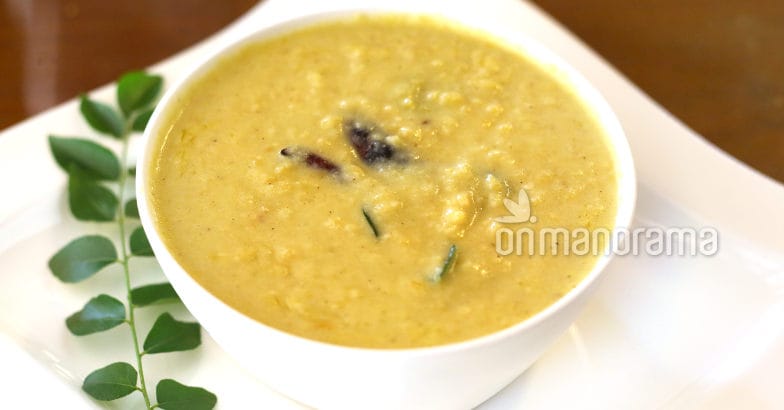
A touch of pickle
The pickle is as old as man. There are records of items being pickled from as old as 4000 years. The race of homo sapiens started developing and evolving into a higher order of the species by virtue of its ability to pickle food and preserve them for years. Historians claim that the early migrants from the north of India to Mesopotamia landed on the alien shores in 2030 BC with kegs of pickled cucumber. Ancient mariners and sailors carried with them huge quantities of pickled pork and beef which kept well for years on end. Even the Bible has referred to pickles twice. The seductive Cleopatra credits her ageless beauty to her daily dose of pickles. And the great Aristotle extols the goodness of pickled cucumbers. Our own Kunjan Nambiar who set his Kaalan Illatha Kaalam into Ottanthullal, refers to a 300-year-old wizened old man whose skin looked like he’d been in brine for ages.
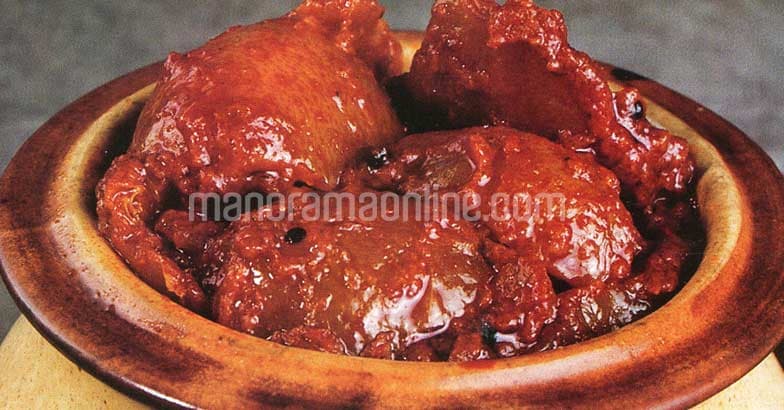
Payasam! Yummy!
Well, the payasam was born in our own land, aver historians. Though there are references to the Romans dining on a concoction of rice boiled in milk way back in 10 BC, there are no records to prove the authenticity of the claims. The earliest references to this sweet gruel can be found in Buddhist and Jain literatures in 400 BC. There are records to prove that payasam was served in the Jagannatha temple of Puri, Odisha, more than 2000 years ago. Kannada manuscripts dating back to 1222 AD refer to a mix, sarvaligeeya, made from vermicelli. Another type of payasam, made from sabun rice, has been referred to in the Kannada literature of 1235 AD.

Manasollasa, the 12th century literary work refers to a controversy as to when payasam ought to be served: Before a meal or after?
Rice
The hero of the piece, however, is the rice…annam Brahma, which means food is God. Paddy was the first food grain the Earth saw. Aeons before the continents formed, there was just one whole land mass and on this huge body of land, it was paddy which first sprouted, it is said. The English word “Rice” is from the scientific stem ”Oryza Sativa”, derived from the Latin parent Orizy. The Latin Orizy crept into Latin from the Tamil “Arisshey”.

Hello Sambar!
Till recently, the wholesome sambar was declared out of bounds for traditional sadyas. A pucca migrant dish, the sambar is the youngest of all recipes to occupy centrestage now. History says the sambar was born two centuries ago in one of Tamil Nadu’s many fiefdoms, in a palace in Thanjavur, to be precise. The 18th century Maratha king Shahulji the First, who ruled Thanjavur loved curries soaked in garcinia (kudam puli). And this special ingredient he was so fond of was sourced from the Vindhya-Satpura ranges. One fine day, Sambhaji, the king’s half brother came calling from Maharashtra. The king ordered a special garcinia-mix curry for his brother as a gesture of affection. However, the chief cook was unaware of the fact that he had not a pod of garcinia left for a dish. Rising to the occasion, a resourceful courtier whipped up a dish with ordinary tamarind and asafoetida and served the hot-tempered king. Now the hot-headed Sambhaji was a culinary expert too. The king heaved a sigh of relief when he saw his half brother heartily spooning the curry. Now you know how sambar derived its name. Sambar for Sambhaji!
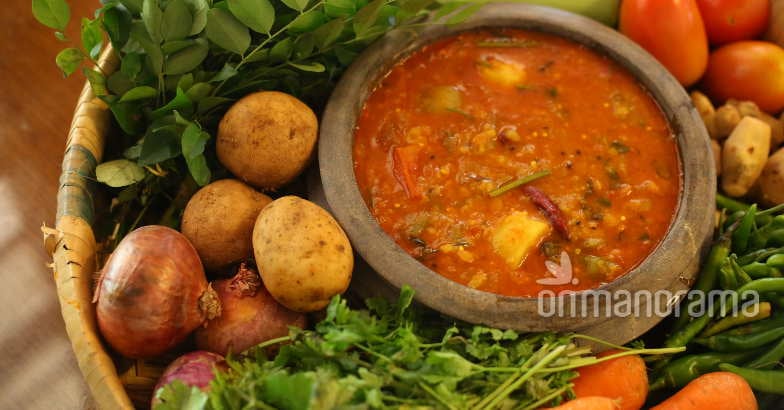
Olan, kaalan, erissery
Are olan and kaalan Kerala specials? Maybe, the belief stemmed from the fact that not too many masalas go into their making. Olan is made in clay pots and its base ingredient is coconut milk.
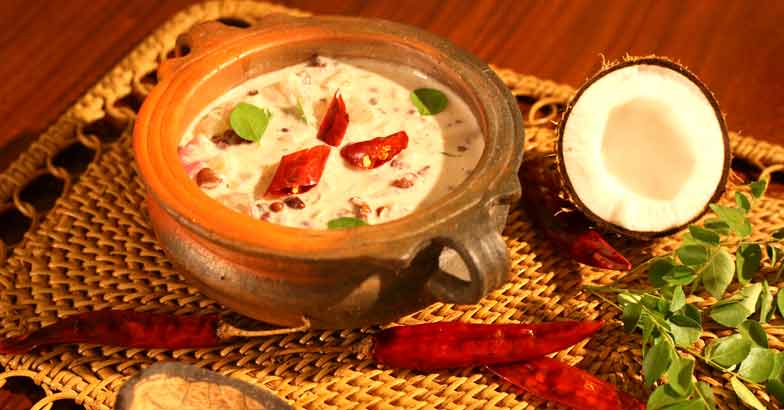
Finely ground coconut, cooked with vegetables cut in squares along with turmeric and curds is our kaalan.
The koottukari is a South Indian favorite. It’s cooked here with coconut, ash gourd and pulses. A variation of this is what we all erisseri.
Order of serving
The tongue of the leaf should be to the left of the diner. Serving begins from the left too. The firsts to be served are salt, lime and mango pickles, injicurry or injithairu, thoran, aviyal, koottukari, kichidi, pachidi and erisseri. The erisseri always takes the extreme right.
On the left again on a row below are served the upperis, plantain and pappad. Next comes the rice followed by parippu curry and ghee. When the main course is almost half done, the sambar is served, after which comes kaalan.
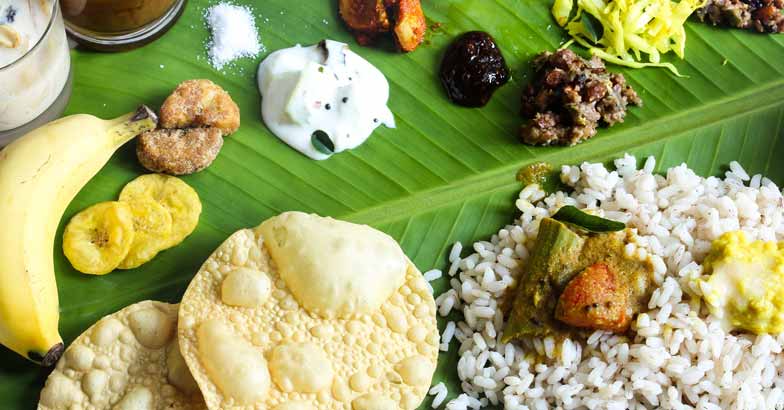
The last and best course of course is the payasam. Payasam is best eaten on the leaf itself mixed with plantain and pappad. A tiny touching of lime pickle would not make the sweetness of the payasam too cloying.
Talking of payasams they come in myriad varieties. By far the most popular ones are banana and ada pradhaman. A spoonful of rice with some curds or butter milk would take the reek of the sweet payasam off your palate. Or if that’s not enough, a palmfull of rasam would do the trick!

